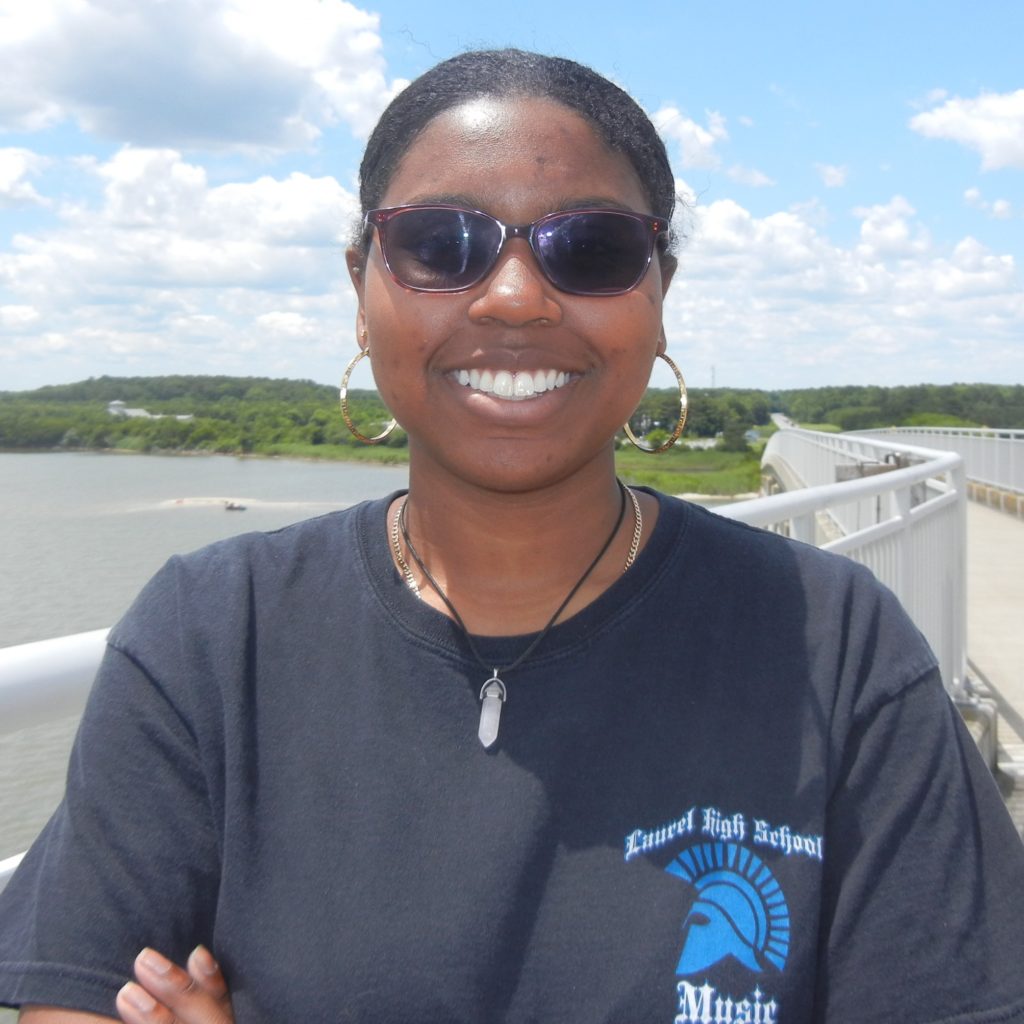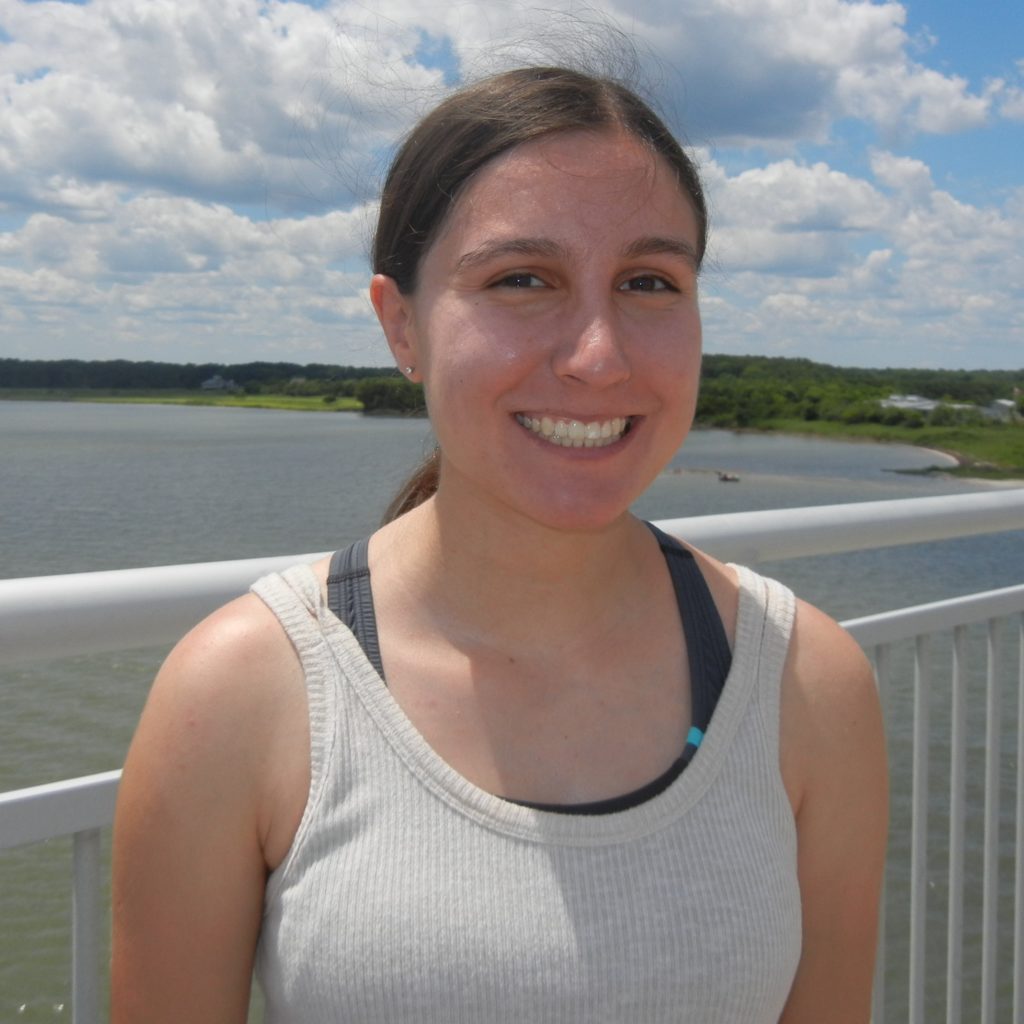2019 Student Participants

Sulaiman Abdul-Aziz, Towson University
Faculty Mentor: Dr. Brad Stevens
Graduate Student Mentor: Maddie Farmer
Assessment and comparison of the biofouling communities in the Maryland Coastal Bays
A biofouling community is a group of organisms that attaches to a substrate, such as piers, bottoms of boats, marinas and docks. As a community, they are used to assess ecological processes such as invasion resistance, predation and competition. Each organism found in the community needs different water quality conditions to survive. We examined two sites (P2 and P3) in the Maryland Coastal Bays near Assateague Island. At each site we suspended 72 PVC settlement plates in either horizontal (36) or vertical (36) orientation in wire cages. Plates were replaced and organisms counted after two weeks and 4 weeks. Although we found over 20 organisms between both sites, we focused our analysis on the five most prevalent species: Barnacles (BA), Branching Bryozoans (BB), Lacy Bryozoans (BR), Worm Tubes (WT) and a Round Encrusted Bryozoan (RT). Cluster analysis showed that the biofouling communities at the two sites were distinct, and settlement was greater on the vertical plates than on the horizontal plates. Although not abundant, Oyster spat or spat scars were more abundant at site P2 (30) than at site P3 (11). Future changes in biofouling community composition can be used to indicate changes in water quality or climate.

Antoinette Adams, Rust College
Faculty Mentors: Dr. Eric May, Dr. Maggie Sexton and Dr. Maryam Taabodi
Characterizing Bacterial Communities within a Dead-End Canal in the Maryland Coastal Bays
Dead-end canals are stagnant, shallow, man-made waterways seen throughout the Maryland Coastal Bays. These channels were made to furnish residents easy access to the water but have become an environmental and human health concern. Dead-end canals do not normally have sufficient water circulation, resulting in insufficient flushing and water turnover. These circumstances lead to accumulation of pollution, organic materials, and sediments at the bottom of the canal, accelerated eutrophication, and potentially adverse effects on human populations. Pathogenic waterborne bacteria can enter the water through inadequately treated sewage, stormwater drains, septic systems, runoff, and human recreational activities. The bacterial diversity was characterized and compared at three different sites: the end of the canal, the mouth, and open water. Samples of surface and bottom water, sediment, and Ctenophores were collected at each site. Triplicate samples were processed and identified using the BIOLOG Microbial Protocol. The overall objective was to see if there is a change in the microbial community between two sites in the canal (mouth, and end) and the open water. The research data shows Vibrio parahaemolyticus was the most abundant species in all samples.

Georgie Alvis (C-StREAM Fellow) Virginia Polytechnic Institute and State University
Faculty Mentor: Dr. Amy Collick
Urea Concentration Dynamics in Relation to Land Use and Weather in the Manokin River Watershed
It is widely agreed upon that nutrient pollution leads to harmful algal blooms. Some algal species prefer urea as a nitrogen source since urea provides both organic carbon and nitrogen. Chemical fertilizers and poultry litter contain high amounts and may serve as sources of urea. The Manokin River drains into the Tangier Sound of the Chesapeake Bay, which currently has a TMDL of a 25% reduction in nitrogen. To monitor urea’s current presence and general movement in the watershed, water samples were collected from 14 sites encompassing the Manokin. Tzilkowski et al, 2019, previously conducted a water quality study of the Manokin from 2010-2011. Changes in urea concentration in relation to land use were analyzed using current urea values and values found in 2010. A direct relationship between wetland area coverage and urea concentration was found to occur in both 2019 (R2=0.7) and 2010 (R2=0.4). Urea concentration decreased from upstream sampling points to downstream. The affect that weather conditions has on urea was analyzed and an inverse relationship between air temperature and urea was observed. This contradicts Tzilkowski and other previous research. The reason for this difference is not yet known. Continued research is required to determine the relationships between urea, land use, and weather.

Rebecca Hernandez, St. Mary’s University
Faculty Mentor: Dr. Salina Parveen
Graduate Student Mentor: Detbra Rosales
Prevalence of Shewanella in Oysters and Seawater in Maryland
Among the abundance of marine life in the Chesapeake Bay (CB) and Maryland Coastal Bays (MCB), oysters are a significant component to the region’s ecosystem and economy. In recent years, research has shown that a pathogenic bacterium, Shewanella, has been found in oyster meat and seawater. As a result, multiple cases of severe Shewanella infections have been reported around the world. In this investigation, oysters and seawater in the CB and MCB will be tested in order to identify a prevalence of Shewanella. It is hypothesized that pathogenic species of Shewanella will be found in oyster meat or seawater. In this investigation, oysters and seawater samples were processed and grown on iron agar (IA) and tryptic soy agar (TSA). Samples were later tested for identification with an API test and hemolysis through plating on blood agar. It was determined that Shewanella grew better on IA than TSA, Shewanella was more prevalent in oysters than seawater, and samples with presumptive Shewanella experienced beta hemolysis the most, which indicates pathogenic properties. Additionally, when tested for identification, more than half of the samples were identified as Shewanella putrefaciens which is a pathogenic species of Shewanella.

Catherine Nguyen, University of Wisconsin-Madison
Faculty Mentor: Dr. Joe Pitula
Graduate student Mentors: Reuel Danquah and Detbra Rosales
Intrageneric Characteristics of Planktothrix isothrix: Microcystin & Nitrogen Fixation Genes
The genus Planktothrixis a cyanobacterium that produces toxic blue-green cyanobacterial blooms and thus impedes the diversity of freshwater ecosystems. Many Planktothrix spp. are harmful to the environment and human health due to their ability to produce toxic microcystins during these blooms. Despite increasing sightings of Planktothrix blooms, little is relatively known about their intrageneric relationships. This study is the first attempt at classifying P. isothrix within the phylogenetic tree of its genera, even though its existence has been previously documented for some time. A P. isothrix sample—isolated from Potomac River, MD—was analyzed through a series of PCR laboratory experiments for the microcystin synthetase gene and the nitrogen fixation cluster gene. The nitrogen fixation gene was absent from the P. isothrix sample, categorizing this species with other Planktothrix spp. devoid of the gene. The microcystin gene could not be identified, with designed primers instead amplifying the TamB gene from a likely co-inhabiting E.coli. This indicates that either P. isothrix contains a gene correspondent to E.coli TamB or the Potomac River was contaminated with enteric bacteria. Future studies will improve upon the PCR technique used in order to amplify microcystin genes and understand their gene expression patterns.

D’Angela Pierre, St. Mary’s College of Maryland
Faculty Mentor: Dr. Dan Cullen
Graduate Student Mentor: Enid Munoz-Ruiz
Concentrations of Microplastics in Local River Systems
The Bluegill (Lepomis) is a type of sunfish that inhabits both fresh and brackish water systems and is a popular fish sought for commercial and recreational fishing. In this study, we sought to look at Microplastics, which have been an emerging topic of study as people have become more aware of the negative effects that can come from an overabundance of plastics in aquatic environments. To examine for microplastics in bluegill, they were collected and their digestive tracts were examined to compare two tidal river systems (The and Pocomoke rivers) on the eastern shore. The anthropogenic activity surrounding to two collection sites differ with more around the Wicomico meaning concentrations of plastics may also differ between the two collection sites. The objective of this study was to find out if there was a significant difference in the amount of plastic found between the two collection sites.

Jonathan Ramsey, Henderson State University
Faculty Mentor: Dr. Andres Morales-Nunez
Graduate Student Mentor: Kayle Krieg
Macroinvertebrate Abundance & Biodiversity, water quality & Sediment Analysis in St Martin’s River and Isle of Wight Bay
Benthic macroinvertebrates are very important organisms in the Maryland Coastal Bays. They provide food for economically important animals like fish, crabs, and birds and some act as pollutant indicators. Analyzing sediment conditions and water quality also provides information on the conditions of the Maryland Coastal Bays. Comparing benthic macroinvertebrate abundance and sediment conditions can provide a better understanding of the condition of the bays. In this study macroinvertebrate abundance, water quality, and organic matter percentage in sediment was analyzed. Four stations were sampled from St. Martin’s River, and Isle of Wight Bay. Samples were collected in June 2019 and processed in June and July. Results showed that in all stations, except station 15, polychaetes were the dominant macroinvertebrate. Station 15 was dominated by amphipods and had a higher number of crustaceans overall. Stations farther north (in St. Martin’s River) had a higher percentage of organic matter than the stations located more towards the south (Isle of Wight bay). The observed results seem to match up with the initial hypothesis that, based on trends from previous studies, stations farther from the inlet tend to have greater macroinvertebrate abundance and diversity than stations closer to the inlet.

Emma Reder, Scripps College
Faculty Mentor: Dr. Ali Ishaque
Graduate Student Mentor: Chelsea Richardson
Food Web Dynamics of Fish in the MCBs
It is necessary to determine accurate food web models in order to develop conservation techniques to protect marine species. In this study, four methods were used to determine the trophic levels of four fish species: Summer Flounder ( Paralichthys dentatus), Silver Perch (Bairdiella chrysoura), Bay Anchovy (Anchoa mitchilli) and Norfolk Spot (Leiostomus xanthurus). It was hypothesized that the food web between the northern and southern Maryland Coastal Bays (MCBs) would differ due to differences in land use. Freeze-dried fish samples were sent to the Stable Isotope Facility at University of CA, Davis for the analysis of 15N concentrations. Freeze-dried fish samples were processed using MA-3000 Mercury Analyzer to determine the mercury concentrations. For fatty acid analysis, BF3 and hexane were added to fish tissue. The organic extracts were injected into a Gas-Chromatography Mass-Spectroscopy for fatty acid identification and quantitation. Finally, stomach contents were examined for species identification. Based on the preliminary data, stable nitrogen, mercury and fatty acid analyses confirm that there is a difference in the food webs between the northern and southern bays. These tests also show that Spot occupy the lowest trophic level. However, the trophic relations between Silver Perch, Summer Flounder and Bay Anchovy still remain unclear.

Mya Rufus, University of Maryland Eastern Shore
Faculty Mentor: Dr. Ligia DaSilva, Dr. Paulinus Chigbu and Dr. Salina Parveen
Graduate Student Mentor: Jasmine Smalls
Impacts of Environmental Factors on Fecal Coliform Levels in the Maryland Coastal Bays
The presence of fecal coliforms and streptococci such as E.coli and Enterococci in streams suggests that other pathogenic microorganisms might be also present and that swimming and eating shellfish harvested from that area might be a health risk. Temperature, pH, and salinity are the physical parameters looked at to see if there is a correlation between them and coliform abundance, while collecting and analyzing samples from 10 sites on the MCBs using MPN techniques. There were no significant correlation between the physical parameters and bacterial counts. Sites 6 and 18 have high bacterial counts and a slight reduction on coliform counts was observed in 2019.


